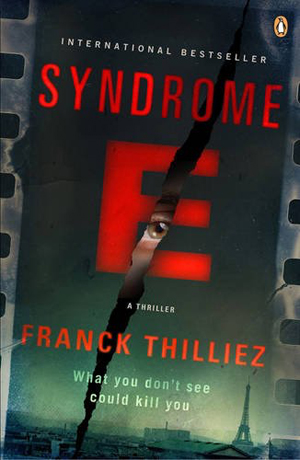
Translated by Mark Pilozzotti — Franck Thilliez has written many bestsellers in his native France. If his other books are of equal quality to this complex, multi-layered thriller, then Penguin, publisher of this translation, can rest assured it has picked a winner.
Syndrome E packs an awful lot of story into its 365 pages. The narrative moves from France to Egypt to Rwanda and finally to Canada as its two main protagonists try to unravel a mystery that had its origins over half a century ago.
Luci Henebelle is a provincial cop and single mother in Lille, whose obsessive commitment to her work has already cost her her marriage. Chief Inspector Frank Sharko works with the Violent Crimes Unit, based in Paris, as a criminal profiler. His schizophrenia, brought on by a violent tragedy, makes him unfit to work as a homicide detective. As the book begins, these two damaged individuals are strangers, but circumstances force them to work together. One of the delights of Syndrome E is watching how their professional relationship, and then personal friendship, develops. Thilliez reveals in stages their individual traumas, and how these events have fundamentally changed them.
As a national specialist in profiling, Sharko is sent to assist an investigation in Rouen. Five corpses have been found buried – immigrant men who faced violent deaths, the skulls and hands removed, as if in attempt to prevent identification. Sharko goes, and gives what little advice he is able to under such difficult circumstances, but is secretly relieved to be leaving. The disturbing nature of the crime has been provoking hallucinations.
At the same time Henebelle has been visiting on old boyfriend in hospital. The man is a rare film enthusiast, and recently bought some unidentified reels from the estate of a dead collector. He is now in a psychiatric unit recovering from a case of dissociative amnesia and conversion blindness – that is to say the images he watched were apparently so distressing that not only did his unconscious mind wipe his memories of the film, but it also turned him temporarily blind.
Henebelle watches the film, which is silent, and amongst mostly innocuous scenes there is one in which a young girl, who appears to be either drugged or hypnotised, is placed in great peril before she then cuts a bull’s throat. Henebelle takes the film to an academic named Poignet, who identifies a series of subliminal images placed within the film, scenes of sex and violence, which are so short that they would not be recognised consciously but which would cause unexplained dread to the viewer.
Henebelle traces the origin of the film to Quebec by examining the phone records of the deceased collector. Shortly after she receives an anonymous tip, from that very city, that the film is connected to the killings in Rouen, and she arranges to meet a reluctant Sharko. Sharko takes an immediate liking to this driven, young woman, but is reluctant to work with her. He recognises in her a kindred spirit, the need to become immersed in the work to such an extent that it becomes damaging, and Sharko doesn’t want to be exposed to that ever again. He reluctantly agrees to help only when it becomes clear Henebelle will not back off.
And so begins their investigation into a baffling case which quickly spreads to Egypt when Interpol records suggest a similar case of the mass killing of unidentified corpses. Their investigation takes two directions, one into the identity of those involved in the film – the young girl and the adult actress, and the innovative genius who directed it – and the identity of the killers behind the mass murders. Finally what links these two apparently unconnected events becomes clear. The plot, complex as it is, benefits from an unfussy and transparent translation. I never got the sense of being one step removed from the author’s original intention.
It appears that Thilliez’s books are being translated for international publication out of the order that they were written, similar to the Jo Nesbo and Arnaldur Indridason books. Syndrome E is so accomplished, in its deft characterisation, in its tight plotting, in the way Thilliez generates a sense of dread (especially as the hidden sequences of the film are revealed), and in the stunning action scenes, that it is no surprise to learn this is not his debut. Finally Thilliez introduces certain historical events into the plot, ones that I was previously unaware of and which are genuinely shocking. Thankfully the research is so comprehensive and the story handled so delicately that it never felt exploitative.
Syndrome E is an expertly achieved balance of the best literary thrillers with blockbuster entertainment. Unreservedly recommended.
For another fine thriller check out Last Words by Michael Koryta by clicking here.
Penguin
Print/Kindle/iBook
£7.12
CFL Rating: 5 Stars